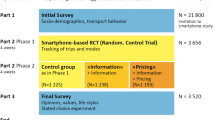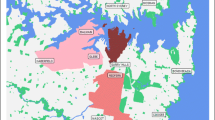Abstract
This methodological paper discusses the implications of differing approaches for tracking tourists’ movement through destinations and then describes an innovative new method that utilises smartphone-based Global Positioning Systems (GPS) technology and a mobile app to track tourists through regional destinations and attractions over an extended period. The method was developed by the Tasmanian Sensing Tourist Travel project team and is among the largest tracking studies ever conducted in tourism, both spatially and temporally and in terms of sample size. It tracked the movement of 472 tourists in real time via an app with three integrated surveys and GPS tracking. The research team was faced with multiple challenges given the ambitious nature of the project, including: app design, securing tracking hardware, forging partnerships with providers, participant recruitment, and the ethical and legal dimensions of both the tracking and the provision of mobile data as an incentive to participate. This paper discusses the lessons from the project and a holistic study design model to support continuous methodological progress in this growing research area.

Similar content being viewed by others
References
Anuar F, Gretzel U (2011) Privacy concerns in the context of location-based services for tourism. In: ENTER 2011 conference, Innsbruck
Asakura Y, Iryo T (2007) Analysis of tourist behaviour based on the tracking data collected using mobile communication instrument. Transp Res Part A Policy Pract 41(7):684–690. doi:10.1016/j.tra.2006.07.003
Beeco JA, Hallo JC (2014) GPS tracking of visitor use: factors influencing visitor spatial behavior on a complex trail system. J Park Recreat Admin 32(2):43–61
Beeco JA, Huang W-J, Hallo JC, Norman WC, McGehee NG, McGee J, Goetcheus C (2013) GPS tracking of travel routes of wanderers and planners. Tour Geogr 15(3):551–573
Birenboim A, Anton-Clavé S, Paolo Russo A, Shoval N (2013) Temporal activity patterns of theme park visitors. Tour Geogr 15(4):601–619
Blečić I, Canu D, Cecchini A, Congiu T, Fancello G, Mauro S, Trunfio GA (2016) Coupling surveys with GPS tracking to explore tourists’ spatio-temporal behaviour. In: International conference on computational science and its applications. Springer, New York, pp 150–160
Curry MR (1997) The digital individual and the private realm. Ann Assoc Am Geogr 87:681–699
De Cantis S, Ferrante M, Kahani A, Shoval N (2016) Cruise Passengers’ behavior at the destination: investigation using GPS technology. Tour Manag 52:133–150
Dou E, Eklund P, Gretzel U (2016) Location privacy acceptance: attitudes to transport-based location-aware mobile applications on a university campus. In: 27th ACIS conference, Wollongong
Edwards D, Griffin T (2013a) ‘Understanding tourists’ spatial behaviour: GPS tracking as an aid to sustainable destination management. J Sustain Tour 21(4):580–595
Edwards D, Griffin T (2013b) Understanding tourists’ spatial behaviour: GPS tracking as an aid to sustainable destination management. J Sustain Tour 21(4):580–595
Edwards D, Dickson T, Griffin A, Hayllar B (2010) Tracking the urban visitor: methods for examining tourists’ spatial behaviour and visual representations. In: Richard G, Munsters W (eds) Cultural tourism research methods. CABI Publishing, Oxford, pp 104–114
Gren M (2001) Time geography matters. In: May J, Thrift N (eds) Timespace: geographies of temporality. Routledge, London, pp 208–225
Grinberger Y, Shoval N, McKercher B (2014a) Typologies of tourists’ time-space consumption: a new approach using GPS data and GIS tools. Tour Geogr 16(1):105–123
Grinberger Y, Shoval N, McKercher B (2014b) Typologies of tourists’ time–space consumption: a new approach using GPS data and GIS Tools. Tour Geogr 16(1):105–123. doi:10.1080/14616688.2013.869249
Hallo J, Beeco J, Goetcheus C, McGee J, Gard McGehee N, Norman W (2012) GPS as a method for assessing spatial and temporal use distributions of nature-based tourists. J Travel Res 51(5):591–606
Harwood A (2011) The political constitution of islandness: the ‘Tasmanian problem’ and ten days on the island. Unpublished PhD thesis, School of Geography and Environmental Studies, University of Tasmania, Hobart
Kadar B (2014) Measuring tourist activities in cities using geotagged photography. Tour Geogr 16(1):88–104
Kellner L, Egger R (2016) Tracking tourist spatial-temporal behavior in urban places, a methodological overview and GPS case study. In: Information and communication technologies in tourism 2016. Springer International Publishing, New York, pp 481–494
Lau G, McKercher B (2006) Understanding tourism movement patterns in a destination: a GIS approach. Tour Hosp Res 7(1):39–49
McKercher B, Lau G (2008) Movement patterns of tourists within a destination. Tour Geogr 10(3):355–374
McKercher B, Lau G (2009) Methodological considerations when mapping tourist movements within a destination. Tour Anal 14(4):443–455
McKercher B, Lew A (2004) Tourist flows, itineraries and factors affecting the spatial distribution of tourists. In: Hall M, Williams A, Lew A (eds) A Companion to Tourism. Blackwell, Oxford, pp 36–48
McKercher B, Shoval N, Ng E, Birenboim A (2012) First and repeat visitor behaviour: GPS tracking and GIS analysis in Hong Kong. Tour Geogr 14(1):147–161
Modsching M, Kramer R, Hagen KT, Gretzel U (2008) Using location-based tracking data to analyze the movements of city tourists. Inf Technol Tour 10(1):31–42
Moussouri T, Roussos G (2015) Conducting visitor studies using smartphone-based location sensing. J Comput Cult Herit. doi:10.1145/2677083
O’Connor A, Zerger A, Itami B (2005) Geo-temporal tracking and analysis of tourist movement. Math Comput Simul 69(1/2):135–150
Pettersson R, Zillinger M (2011) Time and space in event behavior: tracking visitors by GPS. Tour Geogr 13(1):1–20
Prweb.com (2014) A recent study shows that 91% of iPhone users are getting by on a minimal level of storage, and 22% of all smartphone users are running out of space on a monthly basis. http://www.prweb.com/releases/2014/12/prweb12395977.htm. Accessed 10 Oct 2016
Raun J, Ahas R, Tiru M (2016) Measuring tourism destinations using mobile tracking data. Tour Manag 57:202–212
Schautz AM, van Dijk EM, Meisert A (2016) The use of audio guides to collect individualized timing and tracking data in a science center exhibition. Visit Stud 19(1):96–116
Shoval N, Ahas R (2016) The use of tracking technologies in tourism research: the first decade. Tour Geogr 18:587–606
Shoval N, Isaacson M (2007) Tracking tourists in the digital age. Ann Tour Res 34:141–159
Shoval N, McKercher B, Ng E, Birenboim A (2011) Hotel location and tourism activity in cities. Ann Tour Res 38(4):1594–1612
Shoval N, Kwan M, Reinau K, Harder H (2014) The shoemaker’s son always goes barefoot: implementation of GPS and other tracking technologies for geographic research. Geoforum 51(1):1–5
Smith S (2010) Practical Tourism Research. CABI
Smith W, Li X, Pan B, Witte M, Doherty S (2015) Tracking destination image across the trip experience with smartphone technology. Tour Manag 48:113–122
Spangenberg T (2014) Development of a mobile toolkit to support research on human mobility behaviour using GPS trajectories. Inf Technol Tour 14(4):317–346
State of Tasmania (2015a) The Tasmanian Visitor Economy Strategy 2015–2020. Tasmanian Government. http://www.t21.net.au/__data/assets/pdf_file/0004/37723/T21-Strategy-web.pdf Accessed 6 Oct 2016
State of Tasmania (2015b) Access 2020: five year air and sea access strategy 2015–2020. Tasmanian Government. http://www.tourismtasmania.com.au/__data/assets/pdf_file/0011/36983/Tasmanian-Access-2020-Strategy.pdf. Accessed 6 Oct 2016
Thimm T, Seepold R (2016) Past, present and future of tourist tracking. J Tour Futures 2(1):43–55
Thornton P, Williams A, Shaw G (1997) Revisiting time-space diaries: an exploratory case study of tourist behavior in Cornwall, England. Environ Plan A 29(10):1847–1867
Toha MAM, Ismail HN (2015) A heritage tourism and tourist flow pattern: a perspective on traditional versus modern technologies in tracking the tourists. Int J Built Environ Sustain 2(2)
Tourism Australia (2016) Australia welcomes record one million visitors from China. http://www.tourism.australia.com/news/market-regions-greater-china-17742.aspx. Accessed 6 Oct 2016
Tourism Tasmania (2015a) Investigation of tourists as drivers and motorcycle riders in Tasmania and road safety interventions. http://www.rsac.tas.gov.au/wp-content/uploads/2013/07/Tourists-Drivers-and-Motorcycle-Riders-in-Tasmania-and-Road-Safety-Interventions.pdf. Accessed 14 March 2017
Tourism Tasmania (2015b) Tasmanian tourism snapshot. http://tourismtasmania.com.au/__data/assets/pdf_file/0005/39830/TVS-Snapshot-December-2015.pdf. Accessed 14 March 2017
Tourism Tasmania (2016) Tasmanian Tourism Snapshot: year ending March 2016. Tasmanian Government. http://www.tourismtasmania.com.au/__data/assets/pdf_file/0003/41763/TVS-Snapshot-March-2016.pdf. Accessed 6 Oct 2016
Valance E (1995) Business ethics at work. Cambridge University Press, Cambridge
Versichele M, de Groote L, Bouuaert M, Neutens T, Moerman I, Van d Weghe I (2014) Pattern mining in tourist attraction visits through association rule learning on Bluetooth tracking data: a case study of Ghent, Belgium. Tour Manag 22:67–81
Vu HQ, Li G, Law R, Ye BH (2015) Exploring the travel behaviours of inbound tourists to Hong Kong using geotagged photos. Tour Manag 46:222–232
Wang D, Park S, Fesenmaier D (2012) The role of smartphones in mediating the touristic experience. J Travel Res 51(4):371–387
Wang D, Park S, Fesenmaier D (2014) Adapting to the mobile world: a model of smartphone use. Ann Tour Res 48:11–26
Wilken R (2014) Places nearby: Facebook as a location-based social media platform. New Media Soc 16(7):1087–1103. doi:10.1177/1461444814543997
Winters PL, Brabeua SJ, Georggi NL (2008) Smart phone application to influence travel behaviours (TRAC-IT Phase 3) (Report no. 549-35)
Yalowitz SS, Bronnenkant K (2009) Timing and tracking: unlocking visitor behaviour. Visit Stud 12(1):47–64
Yoo K-H, Gretzel U (2011) Influence of personality on travel-related consumer generated media creation. Comput Hum Behav 27(2):609–621
Yoshimura Y, Sobolevsky S, Ratti C (2014) An analysis of visitors’ behaviour in the Louvre Museum: a study of using bluetooth data. Environ Plan B Plan Design 41(6):1113–1131
Yun H, Park M (2015) Time-space movement of festival visitors in rural areas using a smart phone application. Asia Pac J Tour Res 20(11):1246–1265
Author information
Authors and Affiliations
Corresponding author
Rights and permissions
About this article
Cite this article
Hardy, A., Hyslop, S., Booth, K. et al. Tracking tourists’ travel with smartphone-based GPS technology: a methodological discussion. Inf Technol Tourism 17, 255–274 (2017). https://doi.org/10.1007/s40558-017-0086-3
Received:
Revised:
Accepted:
Published:
Issue Date:
DOI: https://doi.org/10.1007/s40558-017-0086-3




